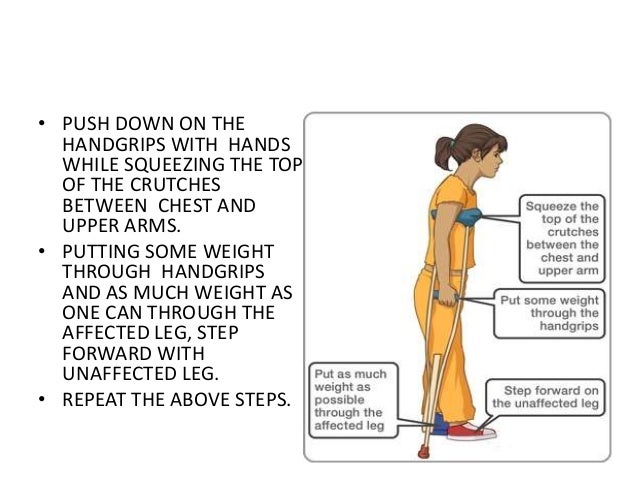CRUTCH WALKING
- function to prevent weight bearing – eventally to walk unaided
- muscles required for using crutches are
- flexors of fingers and thumb to hold the hand grip firmly
- dorsiflexion of wrist and stabilize the wrist in dorsiflexion
- extensors of elbow to stabilize elbow in slight flexion – to take the body wt through upper limb
- flexion of shoulder to move the walking aid forward
- depression of shoulder girdle to support the body wt


- ability to use crutches efficiently depends on
- strength of the muscles required
- selection and adjustment of crutches
- sense of balance
- familiarity and manintance of crutches
- crutch stance
- knowledge of how to stand and balance on crutches before step
- gait pattern
- energy necessary for the gait pattern
- Crutch stance for the axillary crutch
- patient against wall – crutches placed under each arm
- correct stance – head up – back straight – pelvis over feet – shoulder depressed – axillary pads of crutches gripped between the lateral wall of chest and medial aspect of arm , 2 inches below the anterior axillary fold – crutch tips 6 inches forward and 6 inches out from tip of toes – palms of hands on hand grips of crutches – elbows in 300 flexion – body wt taken mainly on hands
- Gait patterns
- swinging crutch gait
- swing to crutch gait
- swing through crutch gait
- four point crutch gait
- two point crutch gait
- three point crutch gait
- selection of gait depends on
- ability of the patient to step forward with either one or two feet
- ability to bear weight and keep balance on one or both feet
- ability to push body forward by presssing down both crutches
- ability to maintain body errect
- ability to control the crutches
- all assisted gaits need more energy
- 2 and 3 point partial weight bearing gaits need 33% more energy than normal gait
- 3 point non weight bearing and swing through gait need 78% more energy
- Swinging Crutch gait
- body wt can be taken through both lower limbs together
- but uncapable of moving his lower limbs due to paralysis
- calipers are used to stabilize the limbs – limbs are moved by the muscles acting on pelvis
- stable position is of tripod – triangular base – apex on shoulder
- crutches form two anterior legs
- trunk and lower limbs form the posterior leg
- paralytic is stable in this position – except no FFD of hip, knee, ankle
- knees braced in extension – centre of gravity falls in front of the hip joint
- swinging to crutch – advances the crutch – swings the body to crutches
- swinging through crutch – body swings through beyond the crutches
- Four point crutch gait
- when all/ part of body wt can be taken on each foot – but patient is unsteady and needs wide based gait
- as condition improves – moves to two point gait
- right crutch – left foot (body wt on right hand) – left crutch – right foot ( body wt on left hand)
- Two point crutch gait
- to reduce the amount of body wt taken on both foot – some body wt can be taken by both l/l – good balance – both lowerlimbs painful/ weak
- right crutch and left foot simoultanously ( taking part of body wt on left foot) - left crutch and right foot simultanously (taking part of body wt on right foot)
- Three point crutch gait
- when one limb can support the whole body wt and other cant
- both crutches support the weak limb – stronger limb takes the whole body wt without support of crutches
- both crutches and weak limb together – stronger lower limb
Orthopaedics made simple for DNB MS MRCS Support and Guidance for DNB Orthopaedics, MS Orthopaedics and Orthopaedic Surgeons. DNB Ortho MS Ortho MRCS Exam Guide Diplomate of National Board.Our site has been helping dnb ortho post graduates since a long time.It has been providing the dnb ortho theory question papers,dnb orthopedics solved question bank, davangere orthopaedic notes, sion orthopedic notes.We provide guidance to post graduates as to how to pass dnb and ms ortho exams, and aspiring orthopaedic surgeons surgical technique teaching videos and orthopaedic books and pdf.
Get updates email orthoguidance@gmail.com whatsapp 9087747888
- Study Material to Pass Any Orthopaedics Exam
- Davangere Orthopaedic notes pdf
- Dawangere Ortho Notes Hard copy all volumes 2017 edition
- DNB Solved Question Bank with Answers
- Ortho Theory Exam Package
- Ortho Practical exam package
- Ortho case presentation videos
- Orthopaedic Journals
- Orthopaedic Physical Examination video Atlas
- Sion Hospital Orthopaedic Notes
- Orthopaedics Proformas and scheme of practical examination
- Orthopaedic instruments videos and extras
- Video Atlas of Human Anatomy
- Ortho Practical Exam Guide
- MRCS Package
- Orthopaedic Surgery Technique teaching videos - Trauma
- Orthopaedic Surgery Technique teaching videos - Arthroplasty
- Orthopaedic Surgery Technique teaching videos - Spine
- Orthopaedic Surgery Technique teaching videos - Shoulder Arthroscopy
- Orthopaedic Surgery Technique teaching videos - Knee Arthroscopy
- Anatomical Approach technique and exposure teaching videos
- Orthopaedic PG Course Videos










"Thank you for the wonderful blog! If you’re looking for Ortho Hospital in T Nagar, I highly recommend checking out the best orthopedic care available in the area."
ReplyDelete